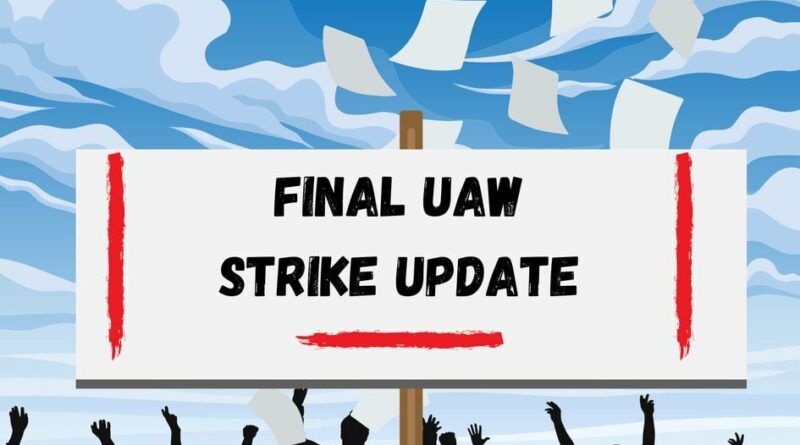Final UAW Strike Update: Contract Ratified
"Now, we take our strike muscle and our fighting spirit to the rest of the industries we represent, and to millions of non-union workers ready to Stand Up and fight for a better way of life,” said UAW President Shawn Fain.
Photo: Canva
After several weeks of strikes, UAW announced on Nov. 20 that members at General Motors, Ford, and Stellantis have all ratified their new contracts, with 64% voting in favor across the three companies.
Contract Provisions
- Raises- Throughout the term of the agreement, union members can expect to receive salary increases of at least 33%, which includes cost of living adjustments as well as compounded wage increases. Some of the lowest-paid workers will receive salary increases of more than 160%. Once the agreement is ratified, tens of thousands of autoworkers will receive immediate raises of over 40%.
- Wage Progression – Restoring the outlined progression in the 2011 contract, the UAW won a three-year wage progression to the top pay rate, down from eight years.
- Reopening – Ford will be reopening affected assembly plants in Michigan, Kentucky, and Illinois, while Stellantis has committed to building a $3.2 billion battery plant for their plant in Belvidere, Illinois, employing more union workers.
- EV Transition – The UAW secured national agreements with all three automakers, promising thousands of new jobs in electric vehicle and battery production under union oversight.
- Retirement Security – Current retirees will receive a $1.25 billion boost to their benefits. The union was unable to restore defined benefit pensions for employees hired after 2007. However, they were able to provide an overall increase in contributions to 401(k) accounts by 10%.
“The Stand Up Strike was just the beginning. The UAW is back to setting the standard. Now, we take our strike muscle and our fighting spirit to the rest of the industries we represent, and to millions of non-union workers ready to Stand Up and fight for a better way of life,” said UAW President Shawn Fain in a recent statement.
Further, Ford and Stellantis have confirmed a ratification bonus of up to $5,000 to be paid out on Dec. 1, according to Detroit News. GM has agreed, but has not announced a date, though the contract states that the bonus must be provided by the same date.
Previous Updates: Week Eight
Following the tentative agreements with the United Auto Workers and the Big Three, UAW President Shawn Fain and Vice President Mike Booth held a news conference from the UAW Solidarity House in Detroit, Mich., to discuss the highlights of the agreements.
"There are some in the corporate offices and corporate media who are not happy with our strike and the lucrative contracts we squeezed out of the Big Three," Fain said. "We've seen an army of analysts and pundits crying that are union is going too far, that we were demanding too much. They said they weren't sure if we would ever get a deal. Then we got all three."
The UAW released highlights from the agreement. They include:
- $10,000 ratification bonus
- Supplemental ratification bonus based on hours worked
- Increased compensation for MPG and the Nursing Units
- Double Time, holiday pay, and RDO Sundays
- Job security language for all UAW-represented salaried employees
- Improved education and training opportunities
- 36% overall increase in full-time salaried bargaining unit membership jobs
- Veterans merit bonus secured during deployment
- Improved Health and Safety Commitment
- 83 paid holidays including Juneteenth
The UAW union said as part of its recent agreement with General Motors, the automaker plans to invest approximately $13 billion in U.S. facilities by April 2028.
Previous Updates : Seventh Week
In the biggest update since the strike began seven weeks ago, the Big Three have all reached tentative agreements with the UAW as of Oct. 30, which sets up to end the strike altogether. A news release from Ford shows they were the first automaker to begin these agreements on Oct. 25, with the other branches following throughout the rest of the week.
According to a video address to the UAW by Fain, he said "This agreement sets us on a new path to make things right at Ford, at the Big Three, and across the auto industry."
The agreements are currently being finalized and will be released digitially soon, but generally include stipulations such as:
- 25% general pay increase over the course of a four-year contract.
- Percent wage increase for veteran workers.
- Securing the right to strike in the future.
In response to the recent news, Ford CEO and President Jim Farley said they are pleased they have seemed to have come to an agreement. "We are focused on restarting Kentucky Truck Plant, Michigan Assembly Plant and Chicago Assembly Plant, calling 20,000 Ford employees back to work and shipping our full lineup to our customers again."
Previous Updates : Sixth Week
The UAW strike is about to enter week six and GM released its third-quarter financial results on Oct. 24, totaling three months of revenue ending on Sept. 30, during the second week of the strike. The results show that, despite the strike, the company was able to make $44 billion in three months. This is roughly the same amount they reported for the second-quarter. The data also reports EBIT earnings of over $3.6 billion. Further, in terms of net revenue, GM claims this quarter is “the best Q3 and Q3 YTD revenue on record.”
According to an article from the UAW released the same day as the financial report, this news has caused them to expand the strike by 5,000 members at Arlington Assembly, just one day after nearly 7,000 UAW workers at Stellantis-owned Sterling Heights Assembly Plant joined the strike.
Previous Updates: Fifth Week
As the UAW strike enters almost six weeks of stalled negotiations with the Detroit Three, analysis from the Anderson Economic Group shows that the companies have accumulated a total economic loss of $7.7 billion, according to an article by Breanna Noble of the Detroit News released on Oct. 17.
Other notable updates for this week include:
- Stellantis announced they are canceling their presentation plans at the Consumer Electronics Show (CES) technology conference expo in Las Vegas due to the loss in revenue.
- At least a thousand more workers represented by the Detroit Casino Council (DCC) have joined the picket line, UAW announced Oct. 17. This is part of a strike by the DCC that represents 3,700 casino workers in total.
- Next week, GM and Ford are set to release their third-quarter earnings, and Stellantis will release its shipments and revenues on Oct. 31.
Previous Updates: Fourth Week
The United Auto Workers’ strike against Detroit’s Big Three automakers entered its fourth week on a much more positive note on Oct. 6, after negotiations made decent progress last week, according to an article from ClickOnDetroit:
UAW President Shawn Fain decided not to expand the union’s strike at General Motors, Ford Motor Company, and Stellantis like he had done the two Fridays prior. The carmakers have been moving closer to the union’s aggressive list of demands, with GM making a big offer on Friday to avoid additional strikes, the union chief said.
The UAW president announced Friday that GM had agreed, in writing, to include electric vehicle battery production in its national agreement with the union — a significant win for autoworkers concerned for their futures amid the nation’s shift to EVs.
As local and national officials encourage automakers to transition to EV production as part of clean energy initiatives, autoworkers have been concerned about being left behind. EVs require fewer people to make them, although those workers require more thorough training. But EVs haven’t been included in the Big Three’s contracts with the UAW, creating worry over job security.
Is the Future Supply & Demand of Electric Vehicles Sustainable?
So far, only GM has agreed to incorporate EV battery production in its UAW contract, but Fain said that the agreement still changes the “future of the union and the industry.”
In a statement sent out Oct. 8, Ford officials said the company remains “open to the possibility of working with the UAW on future battery plants” in the U.S., but did not say the company would offer a proposal similar to GM’s. Instead, Ford said employees have not yet been hired at three of their four known battery plants, where future employees “can choose to be union represented and enter the collective bargaining process.”
Ford reiterated that none of their existing employees would lose their jobs because of EV battery plants “during this contract period.”
Stellantis did not mention EVs in their latest negotiations update, but did say that negotiations were progressing and that leaders remain optimistic.
Each of the Big Three have made several offers to the UAW, and none have been accepted as of Oct. 9 as negotiations continue.
No Strike Expansion Last Week
The UAW is taking a different approach to striking during this year’s negotiations, targeting strikes at increasingly valuable facilities in an effort to create leverage with the automakers, according to the article from ClickOnDetroit.
The strike began at three locations, one for each company, with about 13,000 workers, and has since expanded to about 25,000 workers at 43 facilities across the country.
The union has been expanding its strike each week since the historic strike began on Sept. 15, but UAW President Fain opted to not expand the strike last week at all. In a live social media announcement, Fain said Oct. 6 that he was preparing to announce another strike at GM’s Arlington Assembly facility in Texas — the company’s “biggest money maker” — but didn’t due to GM’s EV agreement.
Record Contract?
This year, UAW leaders have been pushing the same message: The carmakers’ “record profits” should mean “record contracts” for autoworkers.
According to the UAW, the Big Three automakers have amassed a combined total of $21 billion in profit in the first half of 2023, and a combined $250 billion in American profits in the last 10 years. The union argues those “record” profits made in the years after the financial crisis should translate to better compensation for autoworkers, who they say made sacrifices to help the companies stay afloat then.
But the Big Three, each of which has presented multiple counter proposals to the UAW, say their latest offers would be considered “record contracts.” Although the automakers haven’t agreed to the UAW’s request of a 36% wage increase, the companies have upped their offers to around a 20% wage increase.
“Ford’s highest full-year North America adjusted [earnings before interest and taxes] — the most meaningful measure of the underlying profitability of our business — since 2008 was in 2013, 2015 and 2016 — 10, eight and seven years ago. The contract we’re offering would be record pay,” a statement read on Oct. 8.
According to ClickOnDetroit, leading up to Oct. 6, each of the automakers had made several offers to the union: GM made six offers and Ford made seven, while the exact number proposed by Stellantis wasn’t clear. In addition to wage increase percentages, both sides say they’re getting closer on other key issues and benefits, as well.
Ford agreed to restore a cost of living allowance and eliminate wage tiers in their seventh offer that was made last week. Stellantis agreed to restore COLA if inflation exceeds 3%, and to eliminate wage tiers in their parts servicing and customer care division.
In GM’s fifth offer made on Sept. 21, the company reportedly had not agreed to restore a cost of living allowance or to end wage tiers, two of the union’s most prominent demands. Fain said Friday that GM is not far behind the other two carmakers when it comes to COLA.
As the auto industry rebounds after pandemic-related problems, particularly related to the supply chain, automakers say their higher profits are needed amid their massive and expensive investment in the shift toward EVs. The carmakers say they are looking to reach an agreement that is sustainable amid such investments.
Strike locations as of October
A list compiled by ClickOnDetroit, detailing all of the auto facilities where UAW workers were on strike as of Oct. 9, 2023.
GM
- Wentzville Assembly
- Davison Road Processing Center
- Flint Processing Center
- Lansing Redistribution
- Pontiac Redistribution
- Willow Run Redistribution
- Ypsilanti Processing Center
- Chicago Parts Distribution
- Cincinnati Parts Distribution
- Hudson, Wisconsin Parts Distribution
- Denver Parts Distribution
- Reno Parts Distribution Center
- Rancho Cucamonga Parts Distribution
- Fort Worth Parts Distribution
- Martinsburg, West Virginia Parts Distribution
- Jackson, Mississippi Parts Distribution
- Charlotte, North Carolina Parts Distribution
- Memphis AC Delco Parts Distribution
- Philadelphia Parts Distribution
- Lansing Delta Township plant
Stellantis
- Toledo Assembly Complex
- Centerline Packaging
- Centerline Warehouse
- Marysville
- Sherwood (Warren)
- Warren Parts
- Quality Engineering Center (Auburn Hills)
- Romulus
- Chicago
- Cleveland
- Milwaukee
- Minneapolis
- Denver
- Los Angeles
- Portland, Oregon
- Atlanta
- Winchester, Virginia
- Orlando
- Dallas
- New York
- Boston
Ford
- Michigan Assembly Plant (final assembly and paint only)
- Chicago Assembly Plant
Auto Supplier is Latest for Layoffs
As the UAW strike entered its 25th day on Oct. 9, local automotive parts supplier Sodecia Automotive Detroit filed notice that it laid off 62% of its workforce while General Motors and Ford Motor Co. also trimmed back, according to an article from the Detroit Free Press:
Sodecia Automotive Detroit in Center Line, a metal stamping facility, laid off 143 employees of its total workforce of 232 people at that location due to the United Auto Workers ongoing Stand Up Strike, according to a Worker Adjustment and Retraining Notification (WARN) filing posted Oct. 9.
The filing said the company gave notice on Sept. 25 of the layoff citing "reduced business/work" as the reason for the temporary layoff of 129 union members and 14 salaried employees at the business. It lists the layoff lasting to Nov. 25.
According to the Detroit Free Press, this is the third company to file a notice with the state about jobs being trimmed in relation to the strike against the Detroit Three car companies.
GM and Ford Lay Off More People
GM said Oct. 9 that it has laid off an additional 155 people across its Toledo Propulsion Systems, Lansing Regional Stamping and Marion Metal Center in Indiana facilities, bringing the total number of employees affected by the strike to about 2,300.
On Oct. 3, GM said it had to begin laying off 163 employees at its Toledo Propulsion Systems. It had previously laid off 358 employees there. On Monday, an additional 72 workers had to be idled, bringing a total of 430 laid off at that facility. GM manufactures transmissions at Toledo for the midsize pickups and cargo vans made at Wentzville Assembly plant in Missouri and the SUVs made at Lansing Delta Township Assembly.
According to the Detroit Free Press, GM laid off 70 people at its Lansing Regional Stamping plant on Friday due to a lack of work because of the strike. At Marion Metal, an additional 13 people were laid off on Friday for a total of 50 people idled at that facility. There are other GM facilities that have experienced layoffs, including nearly 2,000 at its Fairfax Assembly in Kansas.
On Oct. 9, Ford said in a statement that it asked 71 employees at Livonia Transmission Plant to not report to work beginning then. Ford said it was not a lockout, but a layoff as a result of the strike at Chicago Assembly Plant. Livonia Transmission supplies parts used at the Chicago plant. Ford has 1,800 total workers laid off due to the strike, after cutting nearly 500 on Friday.
“While we are doing what we can to avoid layoffs, we have no choice but to reduce production of parts that would be destined for a plant that is on strike,” said Bryce Currie, vice president, Americas Manufacturing and Labor Affairs, Ford Blue in an interview with Detroit Free Press. “Strike-related layoffs are an unfortunate result of the UAW’s strategy.”
The UAW's strike started after the labor contract expired on Sept. 14 and nearly 13,000 UAW workers across the three automakers walked out at three plants that were the first wave of shutdowns. The UAW expanded its strike to include 38 GM and Stellantis parts distribution centers across the nation on Sept. 22, shutting down the facilities that deliver the parts that car dealers need to make repairs to customers' cars. About 5,625 workers walked out in that wave.
Then on Sept. 29, the UAW took strike action at Ford's Chicago Assembly and GM's Lansing Delta Township plant. This past Friday, the union did not extend the strike, saying it is making progress with all three automakers, though gaps remain. It also announced that GM agreed to the demand to include battery plant workers in its master agreement.
September Strike
On Sept. 18, CIE Newcor filed a WARN saying a temporary closing "is possible, but will be determined by the length of the potential UAW — Detroit 3 strike." CIE Newcor makes components for tier 1 suppliers out of its two plants in Michigan: One in Owosso and another in Corunna. That notice said the layoff was expected to start Oct. 2 and last one month. CIE Newcor has not responded to requests for confirmation on whether the layoffs happened.
Wixom-based automotive supplier Eagle Industries on Sept. 25 announced it may need to lay off a substantial portion of its 171 hourly workers, citing "unforeseen business circumstances." At the time, Eagle Industries President John Bull said his company filed the paperwork as a precaution. It employs about 171 hourly workers, but he said any possible layoff would likely affect 55 to 60 employees.
One analysis from the University of Michigan predicted 150,000 people in Michigan could lose their jobs if the strike lasts four weeks.
As the Detroit Free Press has reported, layoffs at parts suppliers are expected to ramp up as the strike against General Motors, Ford Motor Co. and Stellantis continues.
More Workers on Strike
United Auto Workers President Shawn Fain called for 7,000 more employees of Ford and General Motors to go on strike on Sept. 29, according to an article from YahooFinance. He said union members at Ford’s Chicago assembly plant and GM's Lansing Delta Township assembly plant will walk off the job.
"Sadly, despite our willingness to bargain, Ford and GM have refused to make meaningful progress at the table," Fain said.
Stellantis, the third member of Detroit's Big Three, was spared additional strikes this week. Fain said that reflected recent progress in contract talks between the UAW and the company that builds Jeep, Chrysler and Dodge vehicles.
The latest expansion will mean that about 25,000 of the UAW’s 146,000 members will be on strike as the walkout continues.
Fain started a Facebook Live broadcast almost 30 minutes past its scheduled 10 a.m. start time. He said that was because of productive talks with Stellantis on issues including a cost-of-living allowance and the right to strike over plant closures.
He said talks are continuing with all three companies.
In response to the latest walkout announcement, Gerald Johnson, executive vice president for global manufacturing at GM, said in a statement that "calling more strikes is just for the headlines, not real progress."
“We still have not received a comprehensive counteroffer from UAW leadership to our latest proposal made on September 21," he said. "The number of people negatively impacted by these strikes is growing and includes our customers who buy and love the products we build."
In an emailed statement, Ford said it has offered a record contract for its employees, and that "The UAW is holding up the deal primarily over battery plants that will not come online for another two to three years."
Ford is among a number of automakers that have pivoted their businesses toward mass producing electric cars and trucks in addition to the battery components that power the vehicles.
The UAW disputed Ford's characterization, with Fain accusing Ford CEO Jim Farley of "lying" and that the two parties are "far apart on core economic proposals like retirement security and post-retirement healthcare, as well as job security in this EV transition."
This is the second expansion of the strike since it began two weeks ago. In the first phase, workers struck at one manufacturing facility belonging to each company. In the second, workers walked off the job at dozens of distribution centers belonging to GM and Stellantis.
Fain said Ford was spared last week because of progress in talks with that company.
The move comes three days after President Joe Biden appeared alongside striking UAW members in Wayne County, Michigan.
Major demands for the UAW in the strike include a 40% increase in pay over four years, as well as cost-of-living adjustments; greater retirement benefits including pensions, and full pay for a workweek that would be cut to 32 hours from 40.
The automakers have offered record pay increases of about 20%, as well as bonuses and other benefits and the retention of the union's platinum health care.
The UAW is employing a strategy of announcing targeted strikes with just a few hours' notice. It's focusing on key plants that cause other facilities to stop production because of a lack of parts, and it's trying to goad the companies into further concessions by sparing some of them from additional strikes when they made better offers.
Meanwhile the Big Three have laid off several thousand workers at plants affected by the strikes.
Last Wednesday, General Motors said it idled a manufacturing plant in Kansas, and laid off almost all of the approximately 2,000 people working there.
The automaker said in its announcement that there was no work available for most of the people at the Fairfax assembly plant because workers at another GM facility went on strike Sept. 14.
Additionally, the company said, it could not provide supplemental unemployment benefits “due to the specific circumstances of this situation.”
The same day, Stellantis said it would lay off 68 workers at its Toledo machining plant in Perrysburg, Ohio.
Ford Provides Update On UAW Contract Talks
Ford announced on Sept. 29 their response to the growing strike.
“If the UAW’s goal is a record contract, they have already achieved this,” said Ford President and CEO Jim Farley in a recent news release. “It is grossly irresponsible to escalate these strikes and hurt thousands of families.”
Before the strike – on Sept. 12 – Ford made an offer that would mean substantial wins for its workers, including wage increases of more than 20%, traditional cost of living allowances, health care coverage that is in the top 1% for all Americans, eliminating wage tiers, boosting strong retirement contributions, granting more time off and more, according to a . The company has continued to negotiate and improve its offer since Sept. 12.
The billions in costs the UAW leadership is demanding – beyond the billions Ford has offered – would have devastating implications for Ford’s business and the company’s ability to protect good-paying union jobs going forward.
Ford has invested more in UAW-represented employees than any other automaker, standing alone in adding UAW jobs since the Great Recession and exceeding its investment and job commitments for three consecutive UAW contracts.
Source: Read Full Article




